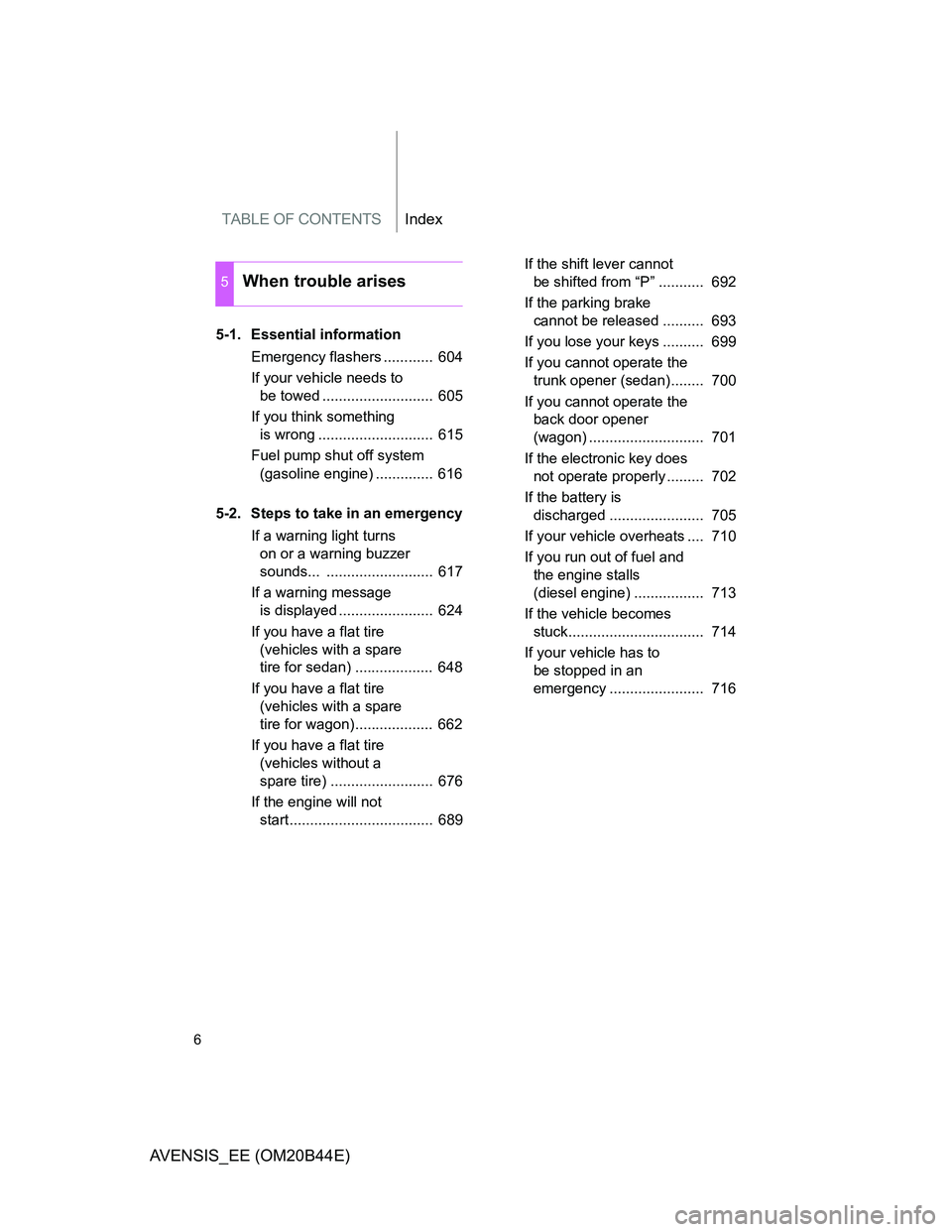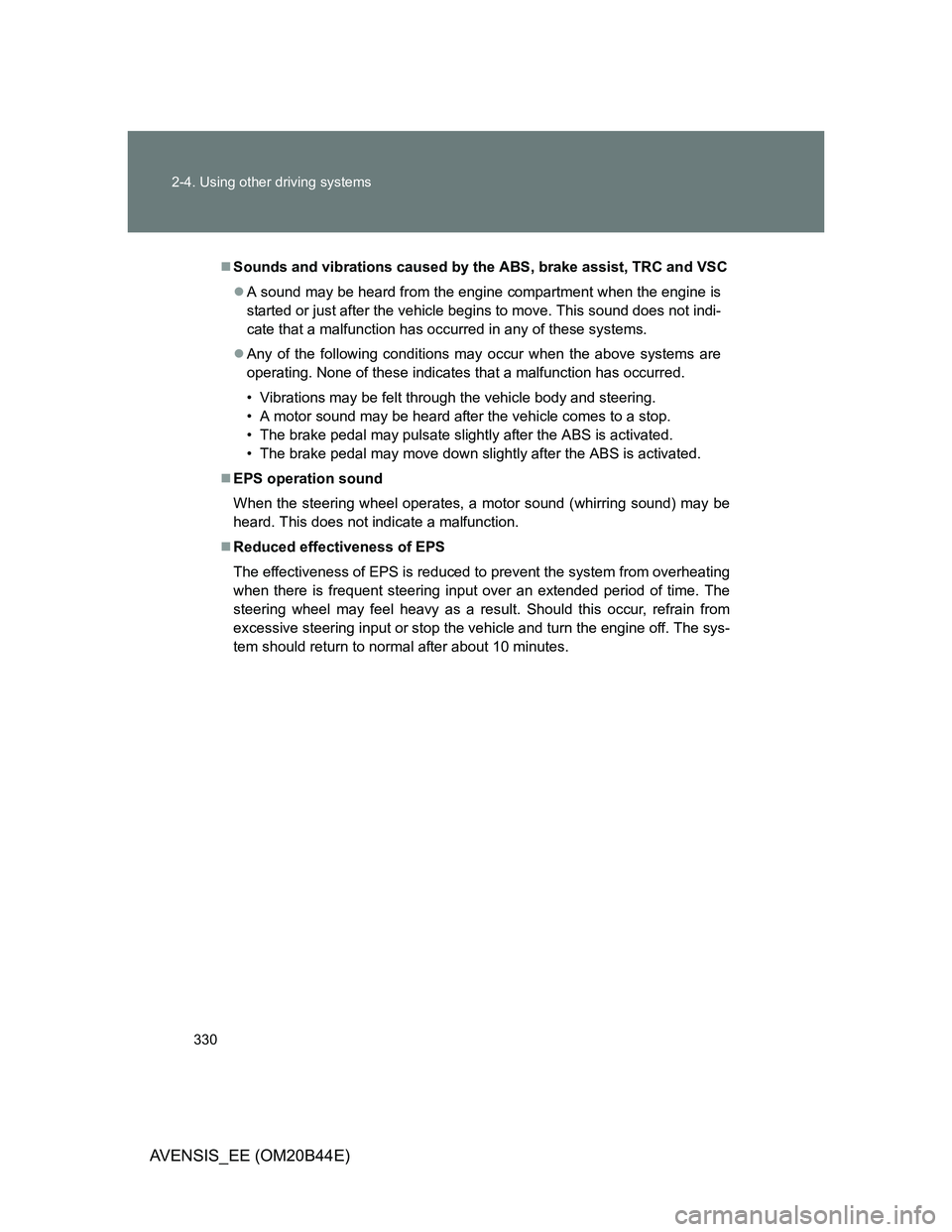Page 6 of 772

TABLE OF CONTENTSIndex
6
AVENSIS_EE (OM20B44E)
5-1. Essential information
Emergency flashers ............ 604
If your vehicle needs to
be towed ........................... 605
If you think something
is wrong ............................ 615
Fuel pump shut off system
(gasoline engine) .............. 616
5-2. Steps to take in an emergency
If a warning light turns
on or a warning buzzer
sounds... .......................... 617
If a warning message
is displayed ....................... 624
If you have a flat tire
(vehicles with a spare
tire for sedan) ................... 648
If you have a flat tire
(vehicles with a spare
tire for wagon)................... 662
If you have a flat tire
(vehicles without a
spare tire) ......................... 676
If the engine will not
start................................... 689If the shift lever cannot
be shifted from “P” ........... 692
If the parking brake
cannot be released .......... 693
If you lose your keys .......... 699
If you cannot operate the
trunk opener (sedan)........ 700
If you cannot operate the
back door opener
(wagon) ............................ 701
If the electronic key does
not operate properly ......... 702
If the battery is
discharged ....................... 705
If your vehicle overheats .... 710
If you run out of fuel and
the engine stalls
(diesel engine) ................. 713
If the vehicle becomes
stuck................................. 714
If your vehicle has to
be stopped in an
emergency ....................... 716
5When trouble arises
Page 202 of 772

202 2-1. Driving procedures
AVENSIS_EE (OM20B44E)
CAUTION
Use engine braking (downshift) to maintain a safe speed when driving
down a steep hill.
Using the brakes continuously may cause the brakes to overheat and lose
effectiveness. (P. 220, 226)
When stopped on an inclined surface, use the brake pedal and parking
brake to prevent the vehicle from rolling backward or forward and causing
an accident.
Do not adjust the position of the steering wheel, the seat, or the inside or
outside rear view mirrors while driving.
Doing so may result in a loss of vehicle control that can cause accidents
that may result in death or serious injury.
Always check that all passengers’ arms, heads or other parts of their bod-
ies are not outside the vehicle, as this may result in death or serious injury.
When driving on slippery road surfaces
Sudden braking, acceleration and steering may cause tire slippage and
reduce your ability to control the vehicle, resulting in an accident.
Sudden acceleration, engine braking due to shift changing, or changes in
engine speed could cause the vehicle to skid, resulting in an accident.
After driving through a puddle, lightly depress the brake pedal to make
sure that the brakes are functioning properly. Wet brake pads may prevent
the brakes from functioning properly. If the brakes on only one side are wet
and not functioning properly, steering control may be affected, resulting in
an accident.
Page 203 of 772

203 2-1. Driving procedures
2
When driving
AVENSIS_EE (OM20B44E)
CAUTION
When shifting the shift lever (vehicles with a Multidrive or automatic
transmission)
Be careful not to shift the shift lever with the accelerator pedal depressed.
This may lead to unexpected rapid acceleration of the vehicle that may
cause an accident and result in death or serious injury.
When the vehicle is stopped
Do not race the engine.
If the vehicle is in any shift positions other than “P” (vehicles with a Multid-
rive or automatic transmission) or “N”, the vehicle may accelerate sud-
denly and unexpectedly, and may cause an accident.
Do not leave the vehicle with the engine running for a long time.
If such a situation cannot be avoided, park the vehicle in an open space
and check that exhaust fumes do not enter the vehicle interior.
Vehicles with a Multidrive or automatic transmission: In order to prevent
accidents due to the vehicle rolling away, always keep depressing the
brake pedal while the engine is running, and apply the parking brake as
necessary.
If the vehicle is stopped on an incline, in order to prevent accidents caused
by the vehicle rolling forward or backward, always depress the brake pedal
and securely apply the parking brake as needed.
Avoid revving or racing the engine.
Running the engine at high speed while the vehicle is stopped may cause
the exhaust system to overheat, which could result in a fire if combustible
material is nearby.
Page 205 of 772

205 2-1. Driving procedures
2
When driving
AVENSIS_EE (OM20B44E)
CAUTION
Exhaust gases
Exhaust gases include harmful carbon monoxide (CO) that is colorless and
odorless. Inhaling exhaust gases may lead to death or a serious health haz-
ard.
If the vehicle is in a poorly ventilated area, stop the engine. In a closed
area, such as a garage, exhaust gases may collect and enter the vehicle.
This may lead to death or a serious health hazard.
The exhaust should be checked occasionally. If there is a hole or crack
caused by corrosion, damage to a joint or abnormal exhaust noise, be
sure to have the vehicle inspected and repaired by any authorized Toyota
dealer or repairer, or another duly qualified and equipped professional.
Failure to do so may allow exhaust gases to enter the vehicle, resulting in
death or a serious health hazard.
When taking a nap in the vehicle
Always turn the engine off.
Otherwise, you may accidentally move the shift lever or depress the acceler-
ator pedal, which could cause an accident or fire due to engine overheating.
Additionally, if the vehicle is parked in a poorly ventilated area, exhaust
gases may collect and enter the vehicle, leading to death or a serious health
hazard.
Page 218 of 772
218 2-1. Driving procedures
AVENSIS_EE (OM20B44E)
NOTICE
To prevent battery discharge
Do not leave the engine switch in the “ACC” or “ON” position for long periods
if the engine is not running.
When starting the engine
Do not crank for more than 30 seconds at a time. This may overheat the
starter and wiring systems.
Do not race the cold engine.
If the engine becomes difficult to start or stalls frequently, have the engine
checked immediately.
Page 244 of 772
244 2-2. Instrument cluster
AVENSIS_EE (OM20B44E)
Instrument panel light control
The brightness of the instrument panel light can be adjusted when
the headlight switch is on.
Darker
Brighter
Tail cancel feature
When turning the instrument panel light control button all the way clockwise
(brighter), the brightness will become suddenly very bright.
Use this feature when driving during daytime with your headlights on, it will
improve visibility of the instrument panel.
NOTICE
To prevent damage to the engine and its components
Do not let the indicator needle of the tachometer enter the red zone, which
indicates the maximum engine speed.
The engine may be overheating if the engine coolant temperature gauge is
in the red zone (“H”). In this case, immediately stop the vehicle in a safe
place, and check the engine after it has cooled completely. (
P. 710)
Page 330 of 772

330 2-4. Using other driving systems
AVENSIS_EE (OM20B44E)
Sounds and vibrations caused by the ABS, brake assist, TRC and VSC
A sound may be heard from the engine compartment when the engine is
started or just after the vehicle begins to move. This sound does not indi-
cate that a malfunction has occurred in any of these systems.
Any of the following conditions may occur when the above systems are
operating. None of these indicates that a malfunction has occurred.
• Vibrations may be felt through the vehicle body and steering.
• A motor sound may be heard after the vehicle comes to a stop.
• The brake pedal may pulsate slightly after the ABS is activated.
• The brake pedal may move down slightly after the ABS is activated.
EPS operation sound
When the steering wheel operates, a motor sound (whirring sound) may be
heard. This does not indicate a malfunction.
Reduced effectiveness of EPS
The effectiveness of EPS is reduced to prevent the system from overheating
when there is frequent steering input over an extended period of time. The
steering wheel may feel heavy as a result. Should this occur, refrain from
excessive steering input or stop the vehicle and turn the engine off. The sys-
tem should return to normal after about 10 minutes.
Page 356 of 772
356 2-5. Driving information
AVENSIS_EE (OM20B44E)Transmission information
Multidrive or automatic transmission
To maintain engine braking efficiency, when using engine brak-
ing, do not use the transmission in “D”. Select an appropriate
gear in “M” mode.
Manual transmission
To maintain engine braking efficiency, when using engine brak-
ing, do not use the transmission in “6”.
If the engine overheats...
Towing a loaded trailer up a long steep incline in temperatures
exceeding 30C (85F) may result in the engine overheating. If the
engine coolant temperature gauge indicates that the engine is
overheating, turn the air conditioning off immediately, leave the
road and stop the vehicle in a safe place. (P. 710)
When parking the vehicle
Always place wheel chocks under the wheels of both the vehicle
and trailer. Firmly set the parking brake and shift the shift lever to
“P” for Multidrive or automatic transmission, and “1” or “R” for man-
ual transmission.